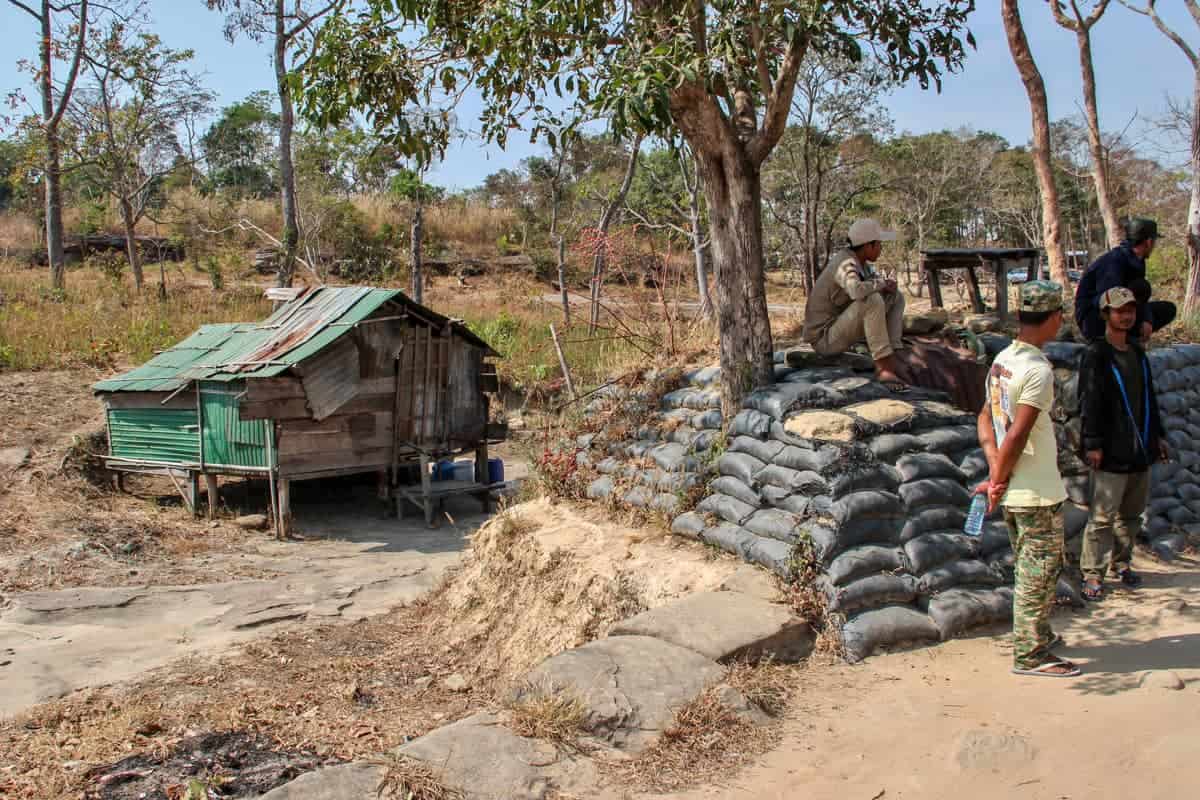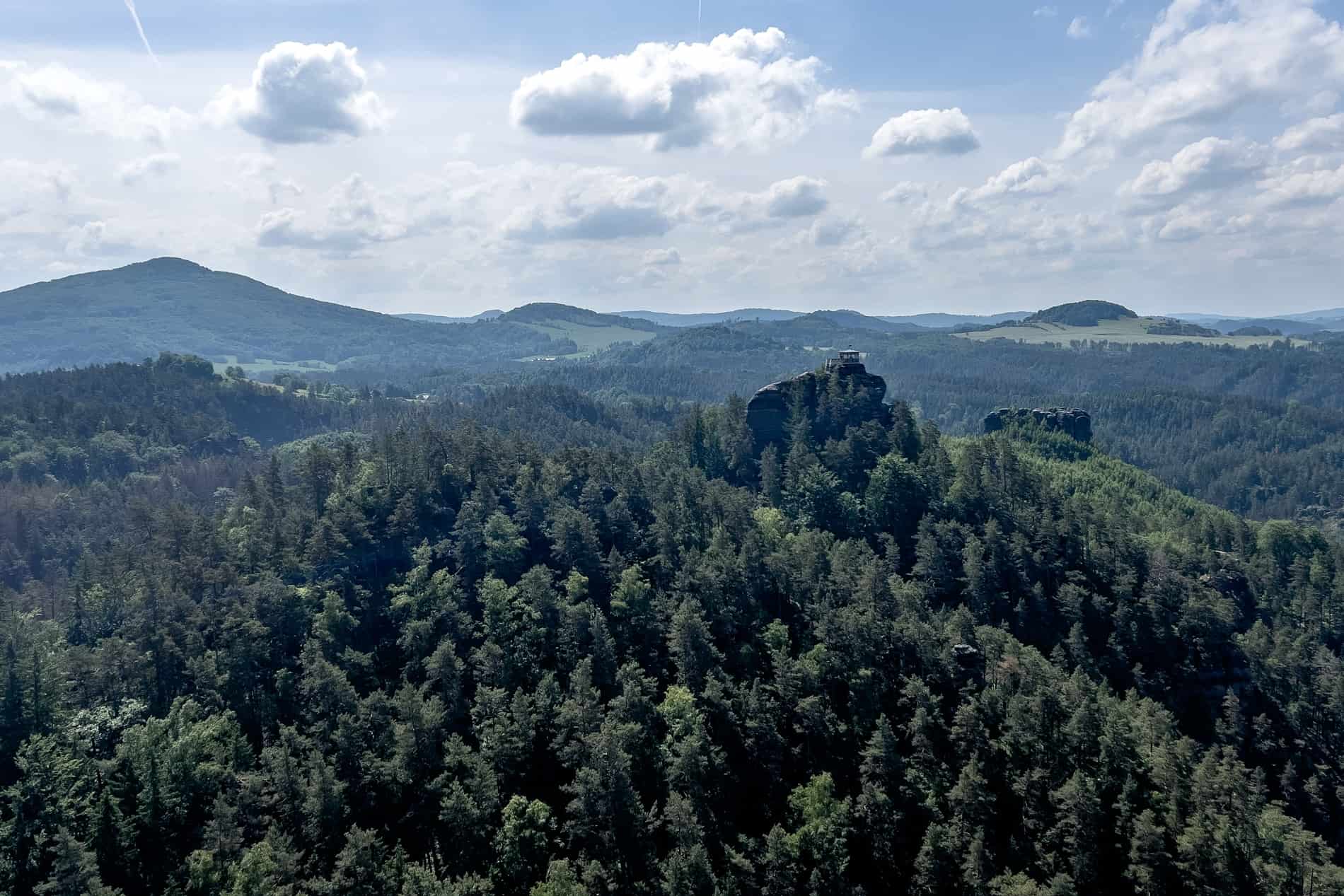The post Preah Vihear Temple, Cambodia – The Archaeological Site and Contested Border appeared first on Borders Of Adventure.
A visit to Preah Vihear Temple, Cambodia is not only an archaeological site but an area of military confrontation over a border dispute.
A four-hour drive north from Siem Reap brings you close to the Thailand border, where a beautiful UNESCO World Heritage site sits atop a steep cliff in the Dangrek Mountains. Yet a visit to the Hindu Preah Vihear Temple will not only bring you into contact with an archaeological site built during the ancient Khmer Empire, but an area of military confrontation as a result of ongoing border tensions.
Visiting this temple is not only painstaking to get to (both in distance and in administration for entry) but is accompanied by a surreal policed presence as you wander around. It’s not frightening at all, but it’s obvious.
As soon as we entered the temple grounds from the steep climb up the first thing we saw was the small military base – sporadic housing, bunkers and watchpoints, accompanied by groups of Khmer army keeping guard. In the distance was a Thailand flag flying high on the parallel cliff face, whose military was also standing their ground.
Yet this was marked by the juxtaposition of an impressive, 900-year-old temple structure. The temple itself, and the land upon which it sits, being the source of contention.

Preah Vihear Temple, Cambodia – Archaeological Site & Contested Border
The Preah Vihear Temple Dispute – Why is There Conflict Over an Archeological Site?
The modern-day history of Preah Vihear and the conflict centres on a dispute between Thailand and Cambodia, that’s been brewing since the early 1900s, over various maps drawn up regarding where the country border lies.
Thailand made its claim by occupying the temple in 1954 after the French troops left Cambodia. In protest, Cambodia asked the International Court of Justice (IJC) to investigate the situation. It resulted in the temple of Preah Vihear being officially handed over to the Cambodians in 1962, based on Thailand’s long-term acceptance of a map drawn up 1907.
However, threats of force continued from both sides.
Then came the years of the Khmer Rouge, who captured the temple in May 1975 and later occupied the border areas. The Vietnamese army invaded Cambodia to overthrow the Khmer Rouge and attacked troops at the temple in December 1978. A war that continued throughout the 1980s and 1990s, and the temple becoming re-occupied by the Khmer Rouge in 1993, followed by the 1998 negotiations that took place at the temple whereby hundreds of members of the Khmer Rouge surrendered to the government.
It has never been a peaceful place.
The Preah Vihear temple case continued when trouble flared again in 2008 after Cambodia applied for the temple’s UNESCO World Heritage site status and Thailand wanted it to be a joint Thai-Cambodia listing. Troops began to station themselves on both sides of the border and exchanges of fire were common, getting particularly worse in 2011 when people were killed and forced to flee the area.
In 2011, Cambodia requested that the ICJ clarify the 1962 ruling, and hearings began in 2013. The verdict was for Thailand to withdraw troops from the area and that Cambodia has sovereignty over most of the disputed land – but not all of it. Cambodia and Thailand continue to work on a peaceful resolution for the temple area and its demilitarised zone.
A more in-depth timeline of the Preah Vihear temple dispute can be found here.

Visiting Preah Vihear Temple, manned by military.
In July 2008, Preah Vihear became a UNESCO World Heritage Site, applied for by Cambodia with initial agreement and support from Thailand. As a result, a new map was drawn up but this only later reignited former tensions with the political opposition in Thailand withdrawing support of the new boundary line agreed.
The conflict has been ongoing between the two countries ever since, with outbreaks of violence in October 2008, April 2009 and February 2011. The International Court of Justice was called in again but it could take years to resolve the border dispute.
There is a ceasefire. For now.
I felt slightly uneasy walking along the path that led to the first entrance of the four-layered temple. The military men were not hostile, but despite the current cease-fire, the atmosphere was a little intimidating.

Army huts, soldiers and sandbags line the entrance path to Preah Vihear temple in Cambodia.
At the same time, it was fascinating to see how two nations dispute over what appears to be a small area of land. Is the temple that important to Thailand?
What a big price to pay for a temple that is Khmer.

Cambodian pride at a contested site.
Visiting the Temple of Preah Vihear in Cambodia
Although tourist police and other military guards were on patrol throughout the temple complex, it wasn’t too distracting during our temple ramblings. In hindsight, it is better to feel safe, although the presence of so many men was a little unsettling at times.
However, it doesn’t detract from the temple’s magnificent structure, which dates back to the 11th century. It is seen as one of the best-preserved examples of Khmer architecture from the Angkor civilisation.
It’s one of the most picturesque and more interesting temples I have visited, more so because of its unique layout. Dedicated to Shiva, Preah Vihear was built as a series of smaller temple sanctuaries linked by grand staircases that stretch for up to 800m and long, wide pavements that lead to stone-arched entranceways.
A beautiful, crumbling ruin, you enter each level through a Gopura (entrance pavilion) after climbing a series of steps, scaling higher and higher until you reach the very top of the cliff face, where you can look out across the vast Cambodian lands that were a once lush, dense jungle. Sadly only a small part of it remains now, following the destruction that comes with modernisation.

Entering the Preah Vihear temple complex.

The relic of Preah Vihear Temple on dusty orange earth.

At the temple of Preah Vihear, which receives few visitors.

Overlooking Preah Vihear Province, Cambodia.
Former Khmer Rouge bunkers are scattered throughout, and some bullet holes are visible on the temple structures. Yet the overall grandeur of the place helps to drown out this somewhat unnerving reminder of past conflicts.

Signs of the Preah Vihear Temple dispute.

Entrance to one of the underground Khmer Rouge bunkers at Preah Vihear.
A contentious but beautiful place. Who knows what will become of the temple of Preah Vihear? Cambodia is certainly standing its ground, but who knows if it will ever end up on Thailand’s soil again.
See it while you can, while there is still relative peace.

Parts of Preah Vihear temple are stacked and held together by wooden beams.

Pockets of calm at the temple site.

Nature reclaiming Preah Vihear.
Preah Vihear Temple Entrance
Entrance to the temple site is free, but you must present a copy of your passport on arrival at the ticket desk at the bottom of the hill.
A ticket is handwritten and attached for later ticket inspections along the steep road route to the top, which can be arranged via a $25 truck (for up to five people) or $5 for a moto ride (not for the faint-hearted!).
The four-hour drive to Preah Vihear from Siem Reap must be arranged privately and costs $60 or more. Therefore it is better to pull together a small group to make this long day trip more cost-effective.
There are limited private tours to Preah Vihear from Siem Reap available, that typically combine a visit to the forested step-temple of Koh Ker.
Interested in the obscure and harder-to-reach temples? READ MORE: Beng Mealea Temple – Finding Angkor’s Jungle Labyrinth

The Preah Vihear temple location is off-track.
The post Preah Vihear Temple, Cambodia – The Archaeological Site and Contested Border appeared first on Borders Of Adventure.











